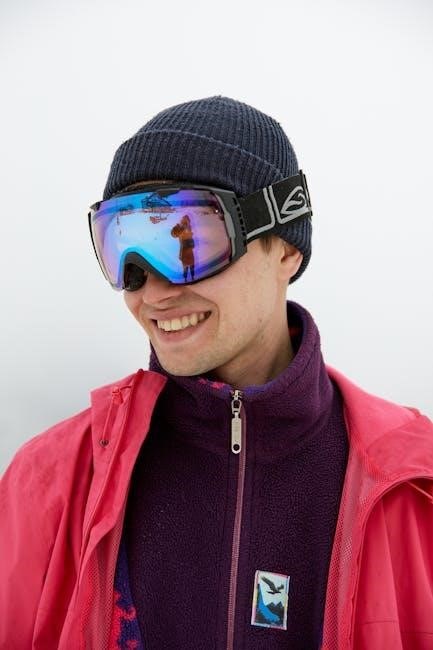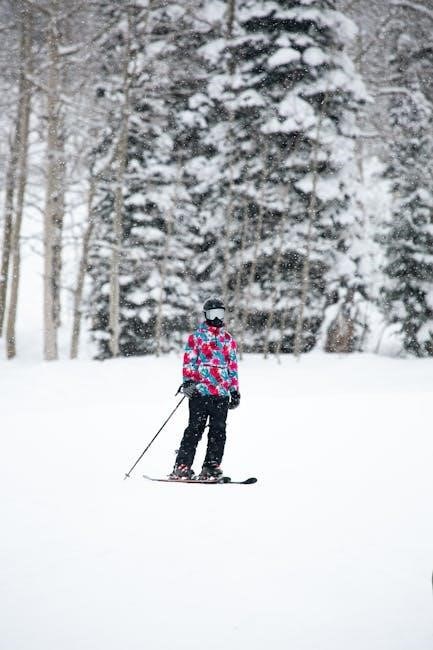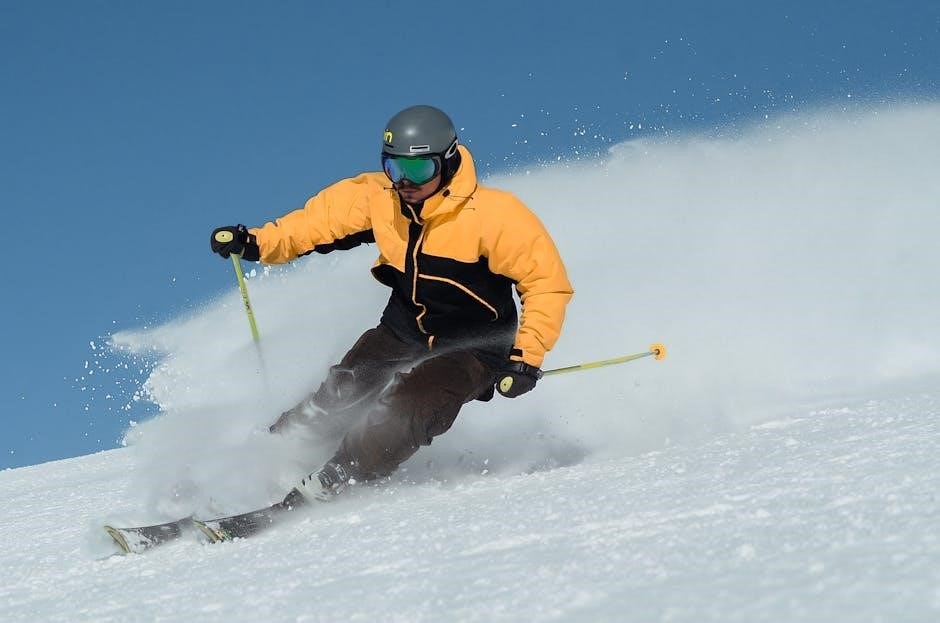Ski goggle lens colors play a crucial role in enhancing visibility and comfort on the slopes․ Different tints and coatings are designed to optimize vision in various light conditions, reducing glare and improving contrast for safer, more enjoyable skiing experiences․
Understanding VLT (Visible Light Transmission)
VLT measures the percentage of visible light passing through a lens, crucial for optimizing vision in varying conditions․ Lower VLT reduces glare in bright light, while higher VLT enhances visibility in low-light settings, ensuring clarity and safety on the slopes․
What is VLT and its importance in ski goggles?
Visible Light Transmission (VLT) refers to the percentage of light that passes through a goggle lens․ It’s a critical factor in choosing the right lens for skiing, as it directly impacts how well you can see in different lighting conditions․ A lower VLT means less light passes through, making it ideal for bright, sunny days to reduce glare․ Conversely, a higher VLT allows more light, enhancing visibility during overcast or low-light situations․ Proper VLT ensures better contrast, reduces eye strain, and improves reaction time, making it essential for safety and performance on the mountain․ Understanding VLT helps skiers select lenses that match their environment, whether carving through powdery slopes under sunny skies or navigating flat light on cloudy days․
How VLT affects visibility in different lighting conditions
Visible Light Transmission (VLT) significantly impacts how well skiers see in various lighting conditions․ In bright, sunny environments, lower VLT lenses (e․g․, 10-30%) reduce glare and provide better contrast, minimizing squinting and eye fatigue․ For overcast or cloudy days, higher VLT lenses (e․g․, 60-90%) allow more light to pass through, improving visibility in flat or low-light conditions․ In variable conditions, such as partly cloudy skies, mid-range VLT lenses (e․g․, 40-60%) offer a balanced compromise, adapting to changing light levels․ The right VLT ensures optimal clarity, reducing the risk of missing obstacles or misjudging terrain․ Proper VLT selection enhances safety, reaction time, and overall skiing performance, making it a vital consideration for any skiing environment․

Lens Color Options for Various Weather Conditions
Different weather demands specific lens colors: dark tints for sunny days, light colors for cloudy conditions, and versatile options for changing skies, ensuring optimal vision and comfort across all environments․
Bright, Sunny Conditions: Dark and Mirrored Lenses
Darker lens options, such as black, gray, or platinum, are ideal for bright, sunny days․ These lenses have lower VLT (Visible Light Transmission) ratings, typically under 25%, which reduces the intense glare from snow and sunlight․ Mirrored coatings on these lenses further enhance glare reduction by reflecting light away from the eyes, providing better visibility and comfort․ The reduced light transmission minimizes eye strain, allowing skiers to perform confidently in strong light conditions․ Additionally, mirrored lenses offer a stylish appearance while maintaining optical clarity․ For those skiing in sunny environments, these darker tints are essential for protecting eyes and improving visual acuity, ensuring a safer and more enjoyable experience on the slopes․ By blocking excessive light, these lenses help skiers maintain focus and react quickly to their surroundings․
Cloudy, Overcast, and Low-Light Conditions: Light-Colored Lenses
In cloudy, overcast, or low-light conditions, light-colored lenses are essential for maintaining visibility; These lenses, often in shades of yellow, amber, or light rose, have higher VLT (Visible Light Transmission) ratings, typically between 60-90%․ This allows more light to pass through, enhancing vision in flat or dimly lit environments․ Yellow and amber lenses are particularly effective as they improve contrast by blocking blue light, which can make surroundings appear washed out in overcast conditions․ This enhanced contrast helps skiers better perceive terrain variations, reducing the risk of accidents․ Light-colored lenses also reduce eye strain caused by low-light conditions, providing clearer and sharper vision․ For skiers navigating through snow flurries or fog, these tints are crucial for maintaining visual clarity and depth perception, ensuring a safer and more enjoyable experience on the mountain․ Light-colored lenses are a must-have for optimal performance in low-light skiing environments․
Partly Cloudy and Variable Conditions: Versatile Lens Colors
For partly cloudy and variable conditions, versatile lens colors are ideal as they adapt to changing light environments․ These lenses typically feature medium tints, such as rose, pink, or blue, with VLT ratings between 40-60%․ They strike a balance between blocking excess light during sunny moments and allowing enough light for visibility during cloud cover․ Rose and pink lenses, for instance, enhance contrast while maintaining moderate light transmission, making them suitable for fluctuating conditions․ Blue and green tints can also be effective, as they help define contours and improve color perception, which is beneficial when the sky transitions between sun and clouds․ Additionally, some lenses incorporate mirror coatings to reduce glare without sacrificing visibility in low-light periods․ These versatile options are perfect for skiers who experience frequent changes in weather, ensuring consistent visual performance throughout their time on the slopes․ Versatile lens colors offer the adaptability needed to handle a wide range of lighting scenarios, making them a practical choice for unpredictable mountain conditions․
Specialized Lens Technologies for Enhanced Performance
Advanced lens technologies like mirrored coatings and polarized filters enhance visibility by reducing glare and optimizing light transmission, ensuring superior clarity and comfort for skiers in various conditions․
Mirrored Coatings: Reducing Glare and Improving Visibility
Mirrored coatings on ski goggle lenses are designed to reduce glare from reflective surfaces like snow and ice․ These coatings work by reflecting a portion of incoming light away from the eye, thereby minimizing the intensity of glare․ This is particularly beneficial in bright, sunny conditions where the snow can act as a mirror, reflecting harmful UV rays and intense light․ By reducing glare, mirrored lenses enhance visibility, allowing skiers to see the terrain more clearly․ This technology is especially useful for individuals who spend extended periods in high-altitude or snowy environments, where the sun’s reflection off the snow can be intense․ Additionally, mirrored coatings often come in various colors, such as silver, gold, or rose, each offering different levels of light transmission and aesthetic appeal․ The combination of reduced glare and improved contrast makes mirrored lenses a popular choice among skiers seeking optimal performance and comfort on the slopes․
Polarized Lenses: Minimizing Glare from Snow and Ice
Polarized lenses are a specialized option for ski goggles, designed to significantly reduce glare from snow and ice․ The polarization process involves embedding a special filter within the lens that blocks horizontally polarized light waves, which are the primary cause of glare from reflective surfaces․ This technology is particularly effective in bright, sunny conditions where the sun’s light reflects off the snow, creating intense glare that can impair visibility․ By minimizing this glare, polarized lenses enhance visual clarity, allowing skiers to see the terrain more distinctly․ This improved visibility can be crucial for navigating challenging slopes or spotting obstacles․ Additionally, polarized lenses often reduce eye strain caused by prolonged exposure to glare, making them a comfortable choice for skiers who spend long hours on the mountain․ However, it’s important to note that polarized lenses may not be suitable for low-light conditions, where maximizing light transmission is more critical․

Contrast Enhancement and Depth Perception
Contrast enhancement and depth perception are vital for skiers to navigate terrain effectively․ Lens tints like yellow, amber, and red boost contrast by blocking blue light, while blue and green tints enhance color perception․
Yellow, Amber, and Red Lenses for Improved Contrast
Yellow, amber, and red lenses are designed to enhance contrast, making them ideal for low-light and flat-light conditions․ These tints block blue light, which can cause glare and reduce clarity, while amplifying warmer tones to improve depth perception․ Skiers benefit from better terrain definition, as these lenses highlight variations in snow texture and contours․ Yellow lenses are particularly effective in foggy or overcast weather, providing greater clarity and reducing eye strain․ Amber and red lenses offer similar benefits but with slightly different color perceptions, catering to individual preferences․ These tints are highly recommended for skiers who frequently encounter challenging light conditions, as they enhance visual acuity and safety on the slopes․ By boosting contrast and reducing glare, yellow, amber, and red lenses help skiers perform at their best, even in less-than-ideal lighting environments․
Blue and Green Lenses for Enhanced Color Perception
Blue and green lenses are favored for their ability to enhance color perception, making them suitable for a variety of skiing conditions․ These tints reduce glare and help define contours, improving the skier’s ability to read the terrain․ Blue lenses are particularly effective in bright, sunny conditions, as they minimize the intensity of blue light reflected from snow, reducing eye strain and improving comfort․ Green lenses offer balanced color perception, making them a versatile choice for both sunny and cloudy days․ They enhance overall visual clarity while maintaining true-to-life colors, which is beneficial for assessing snow conditions and navigating challenging slopes․ Both blue and green lenses are popular among skiers who prioritize visual accuracy and comfort, providing a natural view that aids in detecting subtle changes in the environment․ These tints are ideal for skiers seeking enhanced depth and detail in their field of vision․

Interchangeable Lenses for Versatility
Interchangeable lenses offer adaptability for varying conditions, allowing skiers to switch tints to suit different lighting, enhancing visibility and performance without changing goggles, ensuring optimal vision in any weather․
Benefits of Interchangeable Lenses for Different Conditions
Interchangeable lenses provide unparalleled versatility, allowing skiers to adapt to changing weather and light conditions effortlessly․ Whether it’s swapping a dark mirrored lens for bright sunlight or switching to a light-colored tint for cloudy days, this feature ensures optimal visibility in any scenario․ The ability to customize lens color based on environmental factors enhances safety and performance, reducing eye strain and improving reaction time․ Additionally, interchangeable lenses extend the lifespan of goggles, as they eliminate the need for multiple pairs․ This practical solution is ideal for skiers who experience a wide range of conditions, offering both convenience and cost-effectiveness․ With interchangeable lenses, enthusiasts can enjoy crystal-clear vision and enhanced comfort, regardless of the weather, making them an essential accessory for any serious skier or snowboarder․
UV Protection and Eye Safety
UV protection in ski goggles is essential for safeguarding eyes from harmful ultraviolet rays, which are intensified at high altitudes․ Proper UV protection prevents eye damage and enhances long-term eye health, ensuring safer skiing experiences․
Importance of UV Protection in Ski Goggles
UV protection in ski goggles is crucial for preventing eye damage caused by harmful ultraviolet rays, which are more intense at high altitudes and reflective snow surfaces․ Prolonged exposure to UV light can lead to conditions like snow blindness, cataracts, and macular degeneration, making proper protection essential․ High-quality ski goggles with UV protection block 100% of UVA, UVB, and UVC rays, ensuring eye safety․ This feature is especially vital for skiers and snowboarders who spend extended periods outdoors, as it prevents discomfort and potential long-term vision problems․ By incorporating UV protection, ski goggles not only enhance visual clarity but also safeguard eye health, allowing enthusiasts to enjoy the slopes with confidence and safety․ Always choose goggles with UV protection to maintain optimal eye health during winter sports activities․
Selecting the appropriate ski goggle lens color is essential for optimizing performance and safety on the slopes․ By understanding how different lens tints interact with lighting conditions, skiers can enhance visibility, reduce glare, and improve contrast․ For sunny days, dark or mirrored lenses with low VLT are ideal, while light-colored lenses with high VLT are better suited for cloudy or low-light conditions․ Specialized options like polarized or mirrored coatings offer additional benefits, such as minimizing glare from snow and ice․ Considering factors like UV protection, anti-fog features, and interchangeable lenses can further customize the goggle to meet specific needs․ Ultimately, the right lens color not only improves the skiing experience but also protects eye health, ensuring a safer and more enjoyable time on the mountain․ By matching the lens color to the weather and lighting conditions, skiers can maximize their performance and enjoyment․
